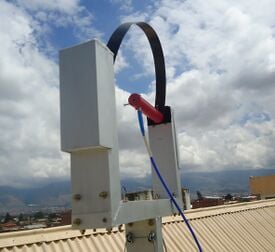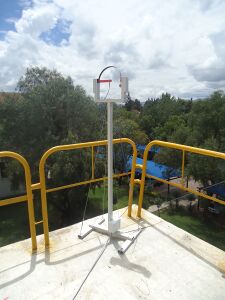J.M.Pearce (talk | contribs) (Created page with "{{UPB}} {{MOST}} ==Source== O. Ormachea ; A. Abrahamse ; N. Tolavi ; F. Romero ; O. Urquidi ; J. M. Pearce ; R. Andrews; [http://proceedings.spiedigitallibrary.org/proceeding...") |
J.M.Pearce (talk | contribs) mNo edit summary |
||
| (8 intermediate revisions by the same user not shown) | |||
| Line 1: | Line 1: | ||
{{UPB}} | {{UPB}} | ||
{{MOST}} | {{MOST}} | ||
{{pearce-pubs}} | |||
==Source== | ==Source== | ||
O. Ormachea ; A. Abrahamse ; N. Tolavi ; F. Romero ; O. Urquidi ; J. M. Pearce ; R. Andrews; [http://proceedings.spiedigitallibrary.org/proceeding.aspx?articleid=1782233 Installation of a variable-angle spectrometer system for monitoring diffuse and global solar radiation]. ''Proc. SPIE 8785, 8th Iberoamerican Optics Meeting and 11th Latin American Meeting on Optics, Lasers, and Applications'', 87850M (November 18, 2013); doi | * O. Ormachea ; A. Abrahamse ; N. Tolavi ; F. Romero ; O. Urquidi ; J. M. Pearce ; R. Andrews; [http://proceedings.spiedigitallibrary.org/proceeding.aspx?articleid=1782233 Installation of a variable-angle spectrometer system for monitoring diffuse and global solar radiation]. ''Proc. SPIE 8785, 8th Iberoamerican Optics Meeting and 11th Latin American Meeting on Optics, Lasers, and Applications'', 87850M (November 18, 2013); DOI: http://dx.doi.org/10.1117/12.2025480 | ||
For preliminary results: | |||
* Omar Ormachea, Faviola Romero, Oscar Urquidi, Augusta Abrahamse, Joshua Pearce, Matthew de Vuono, Rob Andrews. Desarrollo de un sistema de monitoreo de radiación solar basado en un espectrómetro de amplio espectro y análisis de resultados preliminares. ''Procedings of the Simposio Nacional en Energías Renovables'', Cochabamba, Bolivia, 2012. pages 97-104. [https://www.academia.edu/26042563/Desarrollo_de_un_sistema_de_monitoreo_de_radiaci%C3%B3n_solar_basado_en_un_espectr%C3%B3metro_de_amplio_espectro_y_an%C3%A1lisis_de_resultados_preliminares open access] | |||
==Abstract== | ==Abstract== | ||
[[image:va-spectrometer.jpg|275px|right]][[image:va-spec.jpg|225px|left]] | |||
We report on the design and installation of a [[spectrometer]] system for monitoring solar radiation in Cochabamba, Bolivia. Both the light intensity and the spectral distribution affect the power produced by a [[photovoltaic]] device. Local variations in the solar spectrum (especially compared to the [[AM1.5]] standard) may have important implications for device optimization and energy yield estimation. The spectrometer system, based on an Ocean Optics USB4000 (300-900nm) spectrometer, was designed to increase functionality. Typically systems only record the global horizontal radiation. Our system moves a fiber-optic cable 0-90 degrees and takes measurements in 9 degree increments. Additionally, a shadow band allows measurement of the diffuse component of the radiation at each position. The electronic controls utilize an [[Arduino]] UNO microcontroller to synchronizes the movement of two PAP bipolar (stepper) motors with the activation of the spectrometer via an external trigger. The spectrometer was factory calibrated for wavelength and calibrated for absolute irradiance using a Sellarnet SL1-Cal light source. We present preliminary results from data taken March-June, 2013, and comment on implications for PV devices in Cochabamba. | We report on the design and installation of a [[spectrometer]] system for monitoring solar radiation in Cochabamba, Bolivia. Both the light intensity and the spectral distribution affect the power produced by a [[photovoltaic]] device. Local variations in the solar spectrum (especially compared to the [[AM1.5]] standard) may have important implications for device optimization and energy yield estimation. The spectrometer system, based on an Ocean Optics USB4000 (300-900nm) spectrometer, was designed to increase functionality. Typically systems only record the global horizontal radiation. Our system moves a fiber-optic cable 0-90 degrees and takes measurements in 9 degree increments. Additionally, a shadow band allows measurement of the diffuse component of the radiation at each position. The electronic controls utilize an [[Arduino]] UNO microcontroller to synchronizes the movement of two PAP bipolar (stepper) motors with the activation of the spectrometer via an external trigger. The spectrometer was factory calibrated for wavelength and calibrated for absolute irradiance using a Sellarnet SL1-Cal light source. We present preliminary results from data taken March-June, 2013, and comment on implications for PV devices in Cochabamba. | ||
<br> | |||
<br> | |||
==See also== | ==See also== | ||
* [[Open source solar spectrum project]] | * [[Open source solar spectrum project]] | ||
* [[Spectrometer and light source calibration]] | * [[Spectrometer and light source calibration]] | ||
* Download a customizable printable [http://www.thingiverse.com/thing:189726 shadow band] | |||
[[category: | [[category:Photovoltaics]] | ||
[[category: MOST completed projects and publications]] | [[category: MOST completed projects and publications]] | ||
[[category:UPB]] | [[category:UPB]] | ||
[[Category:Open source scientific hardware]] | |||
Revision as of 15:51, 10 June 2016
Source
- O. Ormachea ; A. Abrahamse ; N. Tolavi ; F. Romero ; O. Urquidi ; J. M. Pearce ; R. Andrews; Installation of a variable-angle spectrometer system for monitoring diffuse and global solar radiation. Proc. SPIE 8785, 8th Iberoamerican Optics Meeting and 11th Latin American Meeting on Optics, Lasers, and Applications, 87850M (November 18, 2013); DOI: http://dx.doi.org/10.1117/12.2025480
For preliminary results:
- Omar Ormachea, Faviola Romero, Oscar Urquidi, Augusta Abrahamse, Joshua Pearce, Matthew de Vuono, Rob Andrews. Desarrollo de un sistema de monitoreo de radiación solar basado en un espectrómetro de amplio espectro y análisis de resultados preliminares. Procedings of the Simposio Nacional en Energías Renovables, Cochabamba, Bolivia, 2012. pages 97-104. open access
Abstract


We report on the design and installation of a spectrometer system for monitoring solar radiation in Cochabamba, Bolivia. Both the light intensity and the spectral distribution affect the power produced by a photovoltaic device. Local variations in the solar spectrum (especially compared to the AM1.5 standard) may have important implications for device optimization and energy yield estimation. The spectrometer system, based on an Ocean Optics USB4000 (300-900nm) spectrometer, was designed to increase functionality. Typically systems only record the global horizontal radiation. Our system moves a fiber-optic cable 0-90 degrees and takes measurements in 9 degree increments. Additionally, a shadow band allows measurement of the diffuse component of the radiation at each position. The electronic controls utilize an Arduino UNO microcontroller to synchronizes the movement of two PAP bipolar (stepper) motors with the activation of the spectrometer via an external trigger. The spectrometer was factory calibrated for wavelength and calibrated for absolute irradiance using a Sellarnet SL1-Cal light source. We present preliminary results from data taken March-June, 2013, and comment on implications for PV devices in Cochabamba.
See also
- Open source solar spectrum project
- Spectrometer and light source calibration
- Download a customizable printable shadow band





